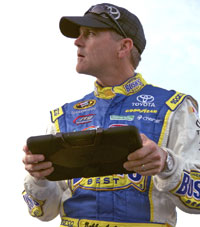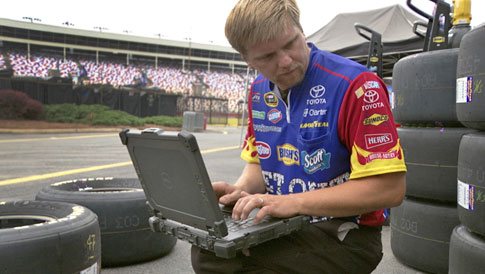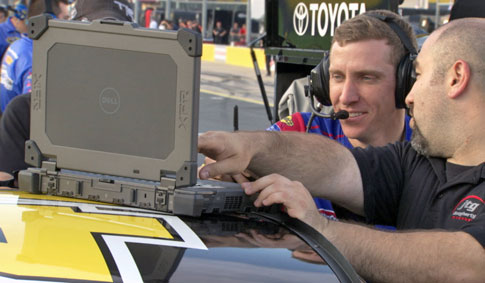Why the JTG Daugherty NASCAR racing team chose rugged Dells
The Christmas tree began its count-down. Yellow, yellow, yellow, GREEN! For an anxious moment, the racing slicks of my supercharged Acura fought for traction, then bit. 8,000, 8,500, 8,800 rpm, shift. Shift. Shift. Shift, and the 1/4-mile at Sacramento Raceway was over. The car slowed and I reached over to stop data logging on the laptop securely sitting on its mount, just having recorded tens of thousands of data points as the car shot down the track. The laptop was a Dell Latitude ATG 630D, connected via USB to the Hondata ECU under the dash of the car. Minutes later I would analyze the run on the Dell, temperatures, shift points, slippage, air/fuel ratio, knocks, timing, etc., and then make changes on the fly. The next heat was in less than 15 minutes.
At the time I didn’t know that a few years later I’d be talking with the JTG Daugherty NASCAR racing team about how they used rugged Dell laptops on their #47 Sprint Cup car,  driven by NASCAR legend Bobby Labonte. Labonte won the Cup in 2000 during an era where he was a perennial contender. And also won IROC in 2001, following in the footsteps of his brother Terry Labonte, also an IROC and Cup champion. Now a senior amongst NASCAR drivers at age 49, Labonte’s piloting car #47 for the team owned by Jodi and Tad Geschickter, and NBA Hall of Famer Brad Daugherty. Lady Luck hasn’t been too kind to them this season, but that’s certainly not due to this talented group and also not due to the technology they’re using. Most recently, while Martin Truex Jr. won at Sonoma Raceway in his Toyota Camry, a blown oil cooler ended Labonte’s race in essentially the same Camry before it even began. Those are the breaks.
driven by NASCAR legend Bobby Labonte. Labonte won the Cup in 2000 during an era where he was a perennial contender. And also won IROC in 2001, following in the footsteps of his brother Terry Labonte, also an IROC and Cup champion. Now a senior amongst NASCAR drivers at age 49, Labonte’s piloting car #47 for the team owned by Jodi and Tad Geschickter, and NBA Hall of Famer Brad Daugherty. Lady Luck hasn’t been too kind to them this season, but that’s certainly not due to this talented group and also not due to the technology they’re using. Most recently, while Martin Truex Jr. won at Sonoma Raceway in his Toyota Camry, a blown oil cooler ended Labonte’s race in essentially the same Camry before it even began. Those are the breaks.
So I felt almost guilty when I got on the phone Monday morning after that race with Matt Corey, who is the IT administrator at JTG Daugherty Racing, and Dell’s Umang Patel and Alan Auyeung to discuss JTG Daugherty’s use of Dell technology. Corey in particular, probably didn’t feel too good after the frustrating weekend and had plenty of other things to do at their shop, but he took the call. Much appreciated.
So how is JTG Daugherty Racing using Dell computers? And what made them decide to use Dell from the driver to the garage and the pit crew to the data center with a complete suite of Dell technology and solutions that also includes rugged Dell ATG and XFR laptops? The choice of Dell for data center and office isn’t much of a surprise, given that Dell has consistently been in the top three PC vendors worldwide and in the US. What’s more interesting is that JTG Daugherty also chose Dell for their rugged laptops, a field dominated by Panasonic, Getac and a number of other vendors specializing on rugged equipment.
Corey began by explaining the inherent need of a NASCAR racing team for rugged technology. No surprises here. There’s rain, dust, vibration, extreme temperatures, the whole gamut of hazards rugged mobile computing gear is designed and built to survive. Add to that the extreme time crunch as a race car is tested and prepared, the extreme need for absolute reliability in a sport where fractions of a second matter, and a race car is checked, refueled and has all of its tires changed in something like 13 seconds. Things simply must not go wrong, ever, in such an environment, and racing teams certainly cannot put up with finicky computing technology that may or may not be up to the job. As an example, Corey tells of an incident where a consumer laptop simply wasn’t able to handle vibration, causing them a lot of grief.

So as a result, JTG Daugherty now uses rugged gear. Their race engineering team has Dell Latitude E6430 ATG laptops. The ultra-rugged Dell Latitude X6420 XFR is used on the truck and trailer. They also use Windows-based Dell Latitude 10 tablets in Griffin Survivor cases supplied by Dell. All of this means that the team can collect performance stats, analyze it, and make changes quickly and reliably. “We have connectivity everywhere,” said Corey. “As the car chief makes a decision about a change to the car, for example, he now notes this on his Latitude 10 and the information is instantly communicated to everyone across the organization. All decisions from the car chief trickle down to updates to the racecar and with everyone synced together with tablets and other Dell technology, that information flow is now much faster, more reliable and more efficient.”

But still, why Dell for the rugged gear? Here I expected Corey to point to the advantage of dealing with a one-stop vendor. Instead he says that they had used Toughbooks in the past and liked them, but that “they really didn’t change much over the years, same always,” and that Dell updates more frequently. “We don’t want “plain vanilla,” he said, “we want to be on the cutting edge of technology” and lists the memory and processing speed required to power through race simulations, high resolution imaging, and massive data sets.
Staying at, or near, the leading edge in technology while still adhering to the longer purchase cycles and life spans of rugged equipment, and guard against obsolescence of docks, peripherals, accessories and software has always been a challenge for the rugged computing industry. While Intel tends to unveil a new processor generation and ancillary technology every 12 to 18 months, the rugged industry cannot possibly update at the same pace. Even Dell is not immune in that regard; as of now, the rugged XFR laptop is still based on the E6420 platform.
Yet, Dell does have the advantage of very high production volume and with that comes access to the very latest technology. Combine that with the convenience and peace of mind of dealing with a large one-stop shop, and it’s no surprise that even a NASCAR racing team chose Dell.
See NASCAR Team Selects Dell to Speed Past the Competition, Dell’s Latitude for Rugged Mobility page, and RuggedPCReview.com’s most recent reviews of the Dell Latitude ATG and Dell Latitude XFR.